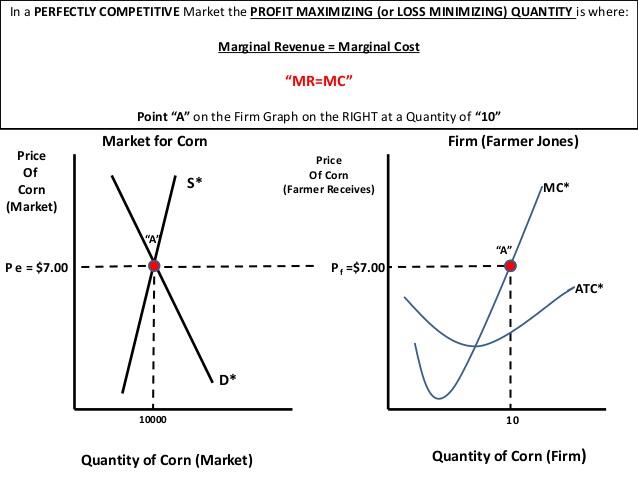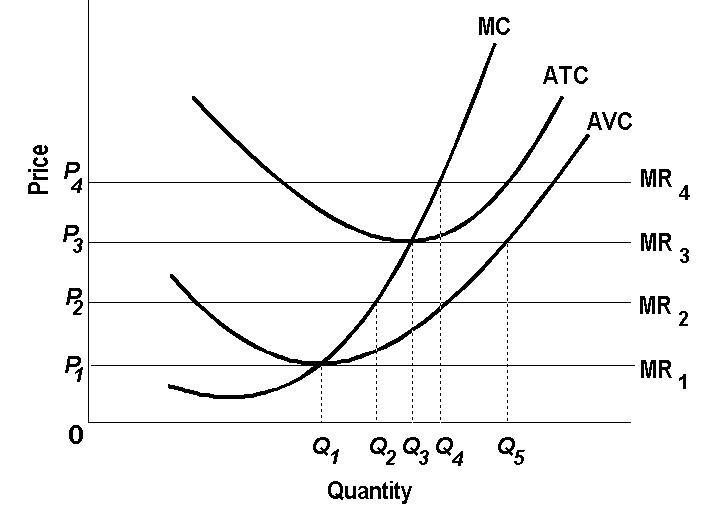Introduction
Ajefu and Barde (2015, p. 20) define a market as “a place where the prices of goods and services are determined.” Comparatively, a perfect market is characterized by the efficient or optimum allocation of resources (Djolov 2014; Maritan & Lee 2017). In this type of market structure, rivals are not in competition with each other because they sell the same goods and services at an identical price (Djolov 2014).
Rodger and Macculloch (2014) say that these are the two main conditions for the development of perfect markets: effective resource allocation and production efficiency. The latter comes from a profit-maximizing model that is characterized by the equality of the price and marginal cost of production. Although it is practically impossible to achieve a perfect market, its dynamics could help to understand market efficiency. This paper uses the aforementioned two preconditions of a perfect economy (effective resource allocation and production efficiency) to explain how an idealized market structure would explain the efficiency of markets.
Production Efficiency
Production efficiency in a perfect market is related to the manufacture of goods and services at the lowest possible cost (Djolov 2014). Such outcomes are developed by tweaking a company’s production capacity to supply more goods to the market and at the lowest possible cost. Stated differently, the prices set by firms will mostly be to recoup production costs (Rodger & Macculloch 2014). If this production model was presented graphically (see figure 1), much of the movements in cost and revenue would occur on the production possibility frontier. However, the achievement of perfect equilibrium between supply and demand does not necessarily mean that there is an efficient allocation of resources because the economic model is only focused on production output (Djolov 2014).
In a perfect market, production efficiency is achieved when there is no wastage (Rodger & Macculloch 2014). Therefore, most production or manufacturing strategies are represented by the production possibility frontier (Rodger & Macculloch 2014). The long-run review of a perfectly efficient market suggests that the market price is equal to the cost of production. Stated differently, goods and services will be sold to customers at the lowest cost of production (Djolov 2014).
Therefore, in such perfect market conditions, the profit motive is often disregarded and the need to be efficient is maximized or prioritized. Comparatively, an imperfect market, such as an oligopoly, does not generate maximum efficiencies because prices are set at a significant mark-up, which is set by the few firms operating in the market (Ajefu & Barde 2015).
Resource Allocation Efficiency
The efficient allocation of resources occurs when there is a perfect production of goods and services in the market. One key characteristic of this type of outcome is the optimal distribution of products and services (Maritan & Lee 2017). The optimal conditions create an environment where the cost of producing goods is similar to their price. Consequently, effective resource allocation efficiency is achieved. This outcome only suffices when a product’s marginal utility is the same as its marginal cost. The resource allocation model demonstrates as much because the point of optimum resource allocation is achieved when the prices consumers pay for products are similar to their utility values (Moscati 2018). Figure 1 below outlines this relationship.

According to the graph above, production will be inefficient at a price below $7 because the customers would be significantly underpaying for the goods sold. However, efficiency could be realized at a cost of $7, because consumers would be willing to pay for the product at the maximum allocation efficiency level. Therefore, pricing the goods above $7 would lead leads to under-consumption. However, if there was a decrease in price, a commensurate increase in society’s enjoyment of the good or service would be reported. Broadly, organizations that compete in a perfect market operate at an allocation efficiency level determined by P=MC. This model is represented in figure 2 below.

Based on figure 2 above, firms that operate in a perfect market are deemed to realize their maximum allocation of resources (efficiency) at level Q1 when P=MC. Comparatively, P3 represents an industry located in a perfectly competitive market. The point of balance is P1 and P3 (for both Q1 and Q3) because perfect competition is realized when the marginal cost of production is at the same point as the market price (Moscati 2018). This focal point also represents the phase of production where resources are perfectly allocated.
According to Q1 above, the point at which the average cost (AVC) intersects with the marginal cost (MC) is deemed the optimum efficiency level of the market. Perfect market conditions occur when production costs are equal to marginal revenues (Moscati 2018). Therefore, any company that wants to maximize its profits should set its market price at the same level as the marginal cost.
The above-mentioned relationship underscores the basis for the development of the neoclassical approach of economics, which formed the basis for the development of the supply curve (Madra 2016). Relative to its use, proponents of the neoclassical theory believe that consumers will always try to maximize personal satisfaction when making a purchase (Morgan 2015). If competition is free and fair, the neoclassical theory contends that there will be an efficient allocation of resources (Barnett et al. 2014).
Therefore, because of the immense power wielded by free-market participants in setting the price of goods and services in a perfect economy, it will be difficult to create monopolistic market behaviors. This is why monopolistic markets do not have a supply curve in the first place. Furthermore, they allocate resources inefficiently because they increase their prices above the marginal cost of production (Barnett et al. 2014). Due to their immense market power, they can influence the market by reducing surplus production through price increases (Madra 2016).
Alternatively, perfect market competition explains the efficiency of the markets through resource allocation. Therefore, in an idealized market, all competing firms should have the same resources for production (Moscati 2018). Alternatively, they should be allocated the same capital to compete effectively with each other. However, this is not often the case because, by design, some firms often have resource advantages over others (Bikker & Spierdijk 2017).
For example, large multinational firms have a disproportionately significant number of resources compared to small and medium-sized firms. Therefore, it is difficult for both sets of firms to compete fairly in the global market. Furthermore, some resources (such as experience and knowledge) are unseen or difficult to quantify (Nason & Wiklund 2018). Consequently, some firms are likely to have a stronger competitive advantage over others.
The resource allocation model suggests that market and economic forces should be designed to maximize social good. Therefore the desired point of production is one that optimizes this outcome (Moscati 2018). Again, it is not possible to make a profit in such a market because there is no mark-up price for products sold in the market (Nason & Wiklund 2018). In other words, goods would be sold in the market to maximize the “social good” and not shareholders’ interests (Bikker & Spierdijk 2017).
Therefore, the prices consumers pay for goods in a perfect market represent their social and not market value. Such perfect markets force firms to set prices that are commensurate with their marginal cost of production because their manufacturing expenses will often align with the social cost of the goods made (Nason & Wiklund 2018). Alternatively, in a perfect market, competing firms will try to maximize their profits using the model P=MC. However, the price they will set will not only cover their production costs but also represent the value that customers will be willing to pay for their goods or services. In this context of analysis, there is a perfect allocation of resources.
Summary
Although this paper has demonstrated how perfect competition helps to achieve market efficiency, the model used is a hypothetical benchmark of production. This is because, in the real world setting where some firms often operate as monopolies or oligopolies, prices are rarely set at their marginal cost of production. Therefore, it is difficult to realize production or resource allocation efficiencies in such settings.
Implicitly, the perfect market competition model ignores pertinent aspects of the real world market, which affect production and efficiency. For example, pollution, innovation, and poverty are key market dynamics that affect demand and supply but are not necessarily captured in the perfectly competitive market model discussed in this document. Therefore, in the real world setting, buyers and sellers have to manage imperfect and unclear information that is pertinent to the market. Broadly, it is also important to acknowledge that perfect markets do not exist and the models outlined in this document are based on hypothetical scenarios. Therefore, the use of the perfect market model to understand efficiency is idealized in a hypothetical environment.
Reference List
Ajefu, JB & Barde, F 2015, ‘Market efficiency and government intervention revisited: what do recent evidence tell us?’, Journal of International Business and Economics, vol. 3, no. 1, pp. 20-23.
Barnett, A, Broadbent, B, Chiu, A, Franklin, J & Miller, H 2014, ‘Impaired capital reallocation and productivity’, National Institute Economic Review, vol. 228, no. 1, pp. 35-48.
Bikker, JA & Spierdijk, L (eds) 2017, Handbook of competition in banking and finance, Edward Elgar Publishing, London.
Djolov, GG 2014, The economics of competition: the race to monopoly, Routledge, London.
Madra, YM 2016, Late neoclassical economics: the restoration of theoretical humanism in contemporary economic theory, Routledge, London.
Maritan, CA & Lee, GK 2017, ‘Resource allocation and strategy’, Journal of Management, vol. 43, no. 8, pp. 2411-2420.
Morgan, J (ed.) 2015, What is neoclassical economics?: debating the origins, meaning and significance, Routledge, London.
Moscati, I 2018, Measuring utility: from the marginal revolution to behavioural economics, Oxford University Press, Oxford.
Nason, RS & Wiklund, J 2018, ‘An assessment of resource-based theorizing on firm growth and suggestions for the future’, Journal of Management, vol. 44, no. 1, pp. 32-60.
Rodger, B & Macculloch, A 2014, Competition law and policy in the EU and UK, 5th edn, Routledge, London.